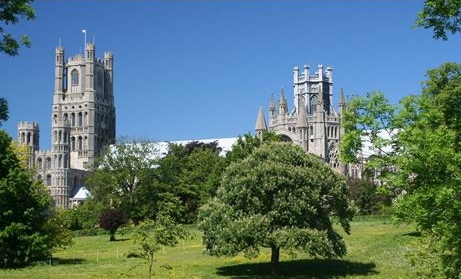Local
history
 |
Photo: Ely Cathedral
by June Francis.
|
Wikipedia article on Caleys.
Introduction
There are several versions of the origin of the Caleys business, some of which are incredible, because they are inconsistent with known facts. The best version is incomplete, because of the sparseness of documentary evidence.
On my own website I can allow myself the luxury of speculation which would not be suitable for Wikipedia, in order to fill in the gaps. So be warned. What follows is not the incontrovertible truth. It is merely a theory.
The Origin of Caleys
The earliest evidence of the existence of the business is an advertisement placed in the Windsor Express in 1813 by M. Caley (clearly Maria). She announces that her business is moving from Thames Street to Castle Street and will be carried on in conjunction with her sister, Mrs Noke. At this time Maria would have been no more than seventeen and I think it unlikely that she would have been running a business entirely on her own for some time.
My contention is that she was working within an existing family business. This had never advertised before, but the newspaper had been founded only in 1812 and so was a novel means of communicating with a business's clientele.
The business was founded, I believe, by John Caley and his sister, Charlotte, round about 1810, or perhaps a little earlier. Later advertisements suggest a pattern of men referring to themselves as 'Silk Mercers' running the mechanics of a business, while their wives or sisters ran dressmaking and millinery operations within the same premises.
William Caley is described as a victualler and he was landlord of the Red Lion on the corner of Bier Lane (now River Street) and Thames Street from 1790 to 1817. There is no evidence of his being a silk mercer. I suggest that he paid for John, his son, to be apprenticed to a silk mercer. In 1810 John would have been about 23 and perhaps he felt ready to start his own business. Maybe Charlotte, who would have been about 18, wanted to start a dressmaking and millinery business. Maria would have been about 14. When she advertised in 1813 she was probably working at home, but whether John and Charlotte were also working in Thames Street or had already established themselves in Castle Street we may never know.
Things would have changed in 1812, when Charlotte married Thomas Noke, a hatter. She would have had new responsibilities and perhaps she trained up Maria to take over from her.
The move from Thames Street to better premises in Castle Street, nearer the entrance to the Castle, would indicate that the business was successful. Maria's advertisement suggests that she was now taking over, but that existing customers should not worry about a drop in quality, because Charlotte would still be involved. However, this is the last we hear of her involvement in the Caley family business; maybe she spent the next few years bearing her children.
Over the next seven years, the business seems to have thrived, with Maria advertising for staff from time to time. John did not advertise, but I imagine he would have been in a back office, writing letters and paying bills. A claim that Maria acquired a royal warrant in 1818 appears to be unfounded. When she advertises in 1819, there is no mention of a warrant. However, archives contain a licence to deal in lace which was purchased for the business. This includes an impressive royal coat of arms!
In 1820 there was a step change in the business. John Caley married Mary Ann Goodman, who had royal warrants. A few weeks after the wedding, she advertises as 'Mrs Caley' and lists her royal patrons, including 'Her late Majesty', that is, Queen Charlotte, who died in 1818.
We do not know how Maria reacted to being displaced by her sister-in-law. Perhaps she recognized that Mary Ann was a huge asset to the business and accepted her new back-seat position.
In 1823 John advertises for the first time to announce the move to the High Street site. The business was clearly thriving. However, we hear nothing of Maria until 1826, when she marries William Goodman, brother of Mary Ann.
The Goodmans moved away from the area, but soon returned and set up a business similar to Caleys in Uxbridge. In 1832 Mrs Caley and Mrs Goodman place similar advertisements in the Windsor Express. The two businesses appear to be co-operating, no doubt engaging in joint purchasing to get lower prices. Mary Ann lists her warrants, but Maria has none.
Note: For fuller details see Windlesora Nos.23 & 24. See also this online article.